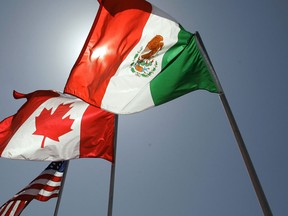
Railways already taking steps to make it easier to ship goods directly, cutting out U.S. middleman

Article content
Leaders and business groups in Canada are taking steps toward expanding the country’s trading relationship with Mexico amid the economic fallout of tariffs imposed by United States President Donald Trump.
Article content
Article content
On May 15, Prime Minister Mark Carney and Mexican President Claudia Sheinbaum spoke about building on the two countries’ current trading relationship and pledged to direct their respective officials to deepen bilateral relations, according to a readout of the call.
Advertisement 2
Article content
Provincial governments are also looking for opportunities to build out trade, and some leaders have made trips to Mexico in hopes of strengthening ties.
Major Canadian businesses see opportunity in expanding trade with Mexico as well. Canadian Pacific Kansas City Ltd. (CPKC) is leveraging its rail network to move goods directly between Canada and Mexico. Meanwhile, agriculture industry groups are looking to continue growing market share in Mexico while some business groups say there is reason to be optimistic about expanding trade with the country.
Such moves come at a critical time for Canada’s economy. In April, Canada’s unemployment rate rose 6.9 per cent amid the loss of 31,000 manufacturing jobs and 27,000 wholesale and retail trade jobs. Economists point to labour market weakness as evidence of the negative impact of U.S. tariffs on the economy.
Advertisement 3
Article content
Here’s what you need to know about Canada’s current trading relationship with Mexico, what could be gained by expanding ties and what some are doing to break into the market.
What does trade look like between Canada and Mexico right now?
Both countries operate under the Canada-United States-Mexico Agreement (CUSMA), signed in 2020 during President Trump’s first term. Before that, both were signatories of the North American Free Trade Agreement (NAFTA), which came into force in 1994.
But trading between the two countries pales in comparison to trade with the United States.
In 2024, Canada exported $434-billion worth of goods to the U.S., according to the United Nations COMTRADE Database. In comparison, Canada exported $8.6-billion worth of goods to Mexico that same year, according to the Conference Board of Canada.
Mexico exported $47-billion worth of goods to Canada in 2024, while its exports to the U.S. were valued at US$506 billion, according to data from the Office of the United States Trade Representative.
Article content
Advertisement 4
Article content
Canada’s top exports to Mexico include agricultural products, autos, metals and minerals, along with chemicals and plastics. Top imports from Mexico include autos, electronic machinery and equipment and industrial machinery. Agricultural products, specifically fruits and vegetables, are also a major import.
How could Canada expand trade with Mexico?
Opportunity might lie in the energy industry, according to one expert.
Shauna Hemingway, a senior special adviser to the Business Council of Canada based in Mexico City, and who previously served as a Canadian diplomat in the country, said she sees room for Canada to grow shipments of liquefied propane gas to Mexico.
Lower demand for gas in Canada during the warmer months could translate into a surplus that could be exported. Mexico might be willing to import that surplus of gas as it seeks to achieve certain goals around energy security, she said.
Advertisement 5
Article content
“Mexico is looking to increase energy security as a national policy, but also (is) very much looking to increase its storage capacity,” Hemingway said.
Another sector that could benefit from the deepening of ties between the countries is manufacturing. Mexico’s labour force is younger than Canada’s and the average factory worker is 35 years old, 10 years younger than a comparable worker in Canada.
“Companies will be looking to the labour force in Mexico as a possible opportunity,” Hemingway said.
Other opportunities for expansion lie in the fertilizer and machinery markets, she said.
Luis Brasdefer, the former Mexico trade commissioner to Canada, who now works as a trade consultant in Vancouver, said he sees both the need and the will to grow trade between the two countries amid uncertainty created by U.S. trade policies. Diversifying trade is one way to help businesses dependent on exports.
Advertisement 6
Article content
“A company, a business needs to have certainty in order to be able to plan and to specifically (develop) an exporting plan,” he said.
He believes there is potential for Canadian and Mexican businesses to collaborate in building strategic alliances that benefit both countries. This might involve Canadian companies working with Mexican companies to innovate using new technologies developed in Canada. On the flip side, Mexican companies could help Canadian businesses build market share in Mexico.
“Opportunity (is there) in most of the sectors,” Brasdefer said.
More opportunity for growth lies in manufacturing, especially in aerospace and automotive, he said.
Why is Mexico an attractive market for Canada?
Mexico’s population is growing — and so is its middle class.
Hemingway said a growing middle class translates into growing demand for consumer goods.
Advertisement 7
Article content
“Their middle class is larger already than the population of Canada,” she said.
Mexico’s population is around 130 million people and has been growing by an average of one per cent a year. Canada’s population was 41.5 million in the first quarter of 2025, according to Statistics Canada.
Another factor that makes Mexico attractive to Canadian investment is that it serves as a gateway to trade with other countries in Latin America.
Brasdefer said establishing a business in Canada gives leaders a better understanding of neighbouring markets and government regulations. That could make it easier for a business to expand beyond Mexico’s borders into an even larger market.
“We’re talking about 500 million people,” Brasdefer said.
What else is being done to expand trade between Canada and Mexico?
Canada’s major railways have taken steps to make it easier to ship goods directly between Canada and Mexico, effectively cutting out the United States middleman.
Advertisement 8
Article content
CPKC, the country’s second largest railway, said it is working to facilitate more direct trade between Canada and Mexico through its rail network.
Keith Creel, the railway’s chief executive, said on a recent earnings call with analysts that CPKC is working with business and government leaders in both countries to help grow trade. He characterized the uncertainty in the current trade environment as an opportunity for the railway.
“Crisis creates opportunities,” Creel said. “And that’s how we’re approaching this uncertainty around tariffs and trade policies.”
He said the railway has already generated $100 million in new business by shipping liquefied gas, along with other refined fuels and plastics, from Alberta to Mexico.
Canadian National Railway Co. (CN), the country’s largest railway, has also made investments to facilitate trade between Canada and Mexico.
Advertisement 9
Article content
In an emailed statement, the railway pointed to a number of initiatives, including Mexico Gulf Express set to launch later this year, which provides round-trip service to connect parts of the U.S. and Canada with central Mexico. CN said it has also partnered with a company that ships rail cars into Mexico via sea ferry.
“This expanded network not only enhances our logistical efficiency but also offers new opportunities for trade and collaboration,” CN said in the statement.
Air travel to Mexico is also increasing. Hemingway said airlines have been seeing an increase in the number of passengers travelling to the country. Recently, Air Canada and Air Transat announced new flights to Guadalajara to help meet the growing demand. But such growth isn’t only limited to moving tourists around, she said.
“That means more air pathways,” Hemingway said. “Certainly, cargo goes along with that.”
Advertisement 10
Article content
What are Canadian business groups doing to expand trade with Mexico?
Some groups have already got to work on selling products to Mexico. One of those organizations is the Prairie Oat Growers Association (POGA), which works to promote the interests of farmers who grow oats.
Oat producers have already benefited from the push to expand trade with Mexico. In March, CPKC transported a shipment of oats from Saskatchewan directly to Mexico for the first time. Previously, shipments had to pass through alternate U.S. railways in order to make the full trip to Mexico.
Shawna Mathieson, executive director of POGA, said Mexico is the second largest importer of Canadian oats. She said the association has worked to promote oats in a number of markets, including Mexico, which has helped producers pivot away from the U.S.
“In 2011, we were up as high as 97 per cent reliance on the U.S.,” Mathieson said. “Now we’re now down closer to about 80 per cent.”
Advertisement 11
Article content
Canadian oat exports to Mexico have grown to 177,000 kilograms in 2024 from 48,000 kilograms in 2014.
POGA has been promoting oats in Mexico through social media campaigns and by working with influencers. It has also set up a key partnership with Mexico’s national diabetes association, promoting recipes made with oats to those living with the disease.
“We set up booths at some of their locations, we work with their dietitians and do both in-person and virtual cooking schools,” Mathieson said.
What are provinces doing to grow trade between Canada and Mexico?
Some premiers are travelling to Mexico to help develop trading relationships.
Saskatchewan Premier Scott Moe led a trade mission to Mexico in February. In an emailed statement, Saskatchewan’s Ministry of Trade and Export Development said the trip reinforced relationships with government leaders and industry leaders in agriculture and value chain sectors.
Advertisement 12
Article content
Before that, in 2022, Saskatchewan opened a regional trade office in Mexico.
Saskatchewan exported over $637-million worth of goods to Mexico in 2024, with the top exports being canola seed and oil along with non-durum wheat, canary seeds and malt. The ministry said the agricultural sector shows the greatest opportunity for growth.
British Columbia has also been working to engage Mexico to strengthen ties and improve trade and the province opened a trade office there in June of 2024.
Diane Gibson, minister of jobs, economic development and innovation, said given the current geopolitical climate, the diversification of trade is crucial. B.C. has made expanding trade with Mexico a priority in its trade diversification strategy, launched in 2023.
“Mexico, along with Taiwan and Vietnam were the three, immediate, high potential markets identified in this strategy,” Gibson said in an emailed statement.
Advertisement 13
Article content
In 2024, B.C. exported $122-million worth of goods to Mexico, with the top exports being coal, lumber, radiation and electrical instruments, along with animal feed and pet food.
Gibson said a range of sectors provide opportunity for growth, including agri-tech, agri-food, clean technologies, mining and mining technology.
The Saskatoon Star Phoenix has created an Afternoon Headlines newsletter that can be delivered daily to your inbox so you are up to date with the most vital news of the day. Click here to subscribe.
With some online platforms blocking access to the journalism upon which you depend, our website is your destination for up-to-the-minute news, so make sure to bookmark thestarphoenix.com and sign up for our newsletters so we can keep you informed. Click here to subscribe.
Article content





Comments